Agricultural Water Use Sustainability Assessment in the Tarim River Basin under Climatic Risks
Abstract
1. Introduction
2. Study Area
3. Methods and Data
3.1. Methods
3.2. Data
4. Results and Discussion
4.1. Agriculture Water Stress Index
4.2. Combined Result of Groundwater Changes from Agricultural Water Consumption and Water Supply
5. Conclusions
Acknowledgments
Author Contributions
Conflicts of Interest
References
- Cao, X.; Wu, M.; Guo, X.; Zheng, Y.; Gong, Y.; Wu, N.; Wang, W. Assessing water scarcity in agricultural production system based on the generalized water resources and water footprint framework. Sci. Total Environ. 2017, 609, 587–597. [Google Scholar] [CrossRef]
- Vörösmarty, C.J.; McIntyre, P.B.; Gessner, M.O.; Dudgeon, D.; Prusevich, A.; Green, P.; Glidden, S.; Bunn, S.E.; Sullivan, C.A.; Liermann, C.R.; et al. Global threats to human water security and river biodiversity. Nature 2010, 467, 555–561. [Google Scholar] [CrossRef] [PubMed]
- Bakker, K. Water security: Research challenges and opportunities. Science 2012, 337, 914–915. [Google Scholar] [CrossRef] [PubMed]
- Le Roux, B.; van der Laan, M.; Vahrmeijer, T.; Bristow, K.L.; Annandale, J.G. Establishing and testing a catchment water footprint framework to inform sustainable irrigation water use for an aquifer under stress. Sci. Total Environ. 2017, 599, 1119–1129. [Google Scholar] [CrossRef] [PubMed]
- Postel, S. Pillar of Sand: Can the Irrigation Miracle Last? WW Norton & Company: New York, NY, USA, 1999. [Google Scholar]
- Li, G.; Harrison, S.P.; Bartlein, P.J.; Izumi, K.; Colin Prentice, I. Precipitation scaling with temperature in warm and cold climates: An analysis of CMIP5 simulations. Geophys. Res. Lett. 2013, 40, 4018–4024. [Google Scholar] [CrossRef]
- Alauddin, M.; Sarker, M.A.R. Climate change and farm-level adaptation decisions and strategies in drought-prone and groundwater-depleted areas of Bangladesh: An empirical investigation. Ecol. Econ. 2014, 106, 204–213. [Google Scholar] [CrossRef]
- Adamson, D.; Loch, A.; Schwabe, K. Adaptation responses to increasing drought frequency. Aust. J. Agric. Resour. Econ. 2017, 61, 385–403. [Google Scholar] [CrossRef]
- Heinemann, A.B.; Ramirez-Villegas, J.; Stone, L.F.; Didonet, A.D. Climate change determined drought stress profiles in rainfed common bean production systems in Brazil. Agric. For. Meteorol. 2017, 246, 64–77. [Google Scholar] [CrossRef]
- Dou, X. A critical review of groundwater utilization and management in China’s inland water shortage areas. Water Policy 2016, 18, 1367–1383. [Google Scholar] [CrossRef]
- Shang, H.; Wang, W.; Dai, Z.; Duan, L.; Zhao, Y.; Zhang, J. An ecology-oriented exploitation mode of groundwater resources in the northern Tianshan Mountains, China. J. Hydrol. 2016, 543, 386–394. [Google Scholar] [CrossRef]
- Scott, C.A. Electricity for groundwater use: Constraints and opportunities for adaptive response to climate change. Environ. Res. Lett. 2013, 8, 035005. [Google Scholar] [CrossRef]
- Ma, J.Z.; Wang, X.S.; Edmunds, W.M. The characteristics of ground-water resources and their changes under the impacts of human activity in the arid Northwest China—A case study of the Shiyang River Basin. J. Arid Environ. 2005, 61, 277–295. [Google Scholar] [CrossRef]
- Moore, S.; Fisher, J.B. Challenges and opportunities in GRACE-based groundwater storage assessment and management: An example from Yemen. Water Resour. Manag. 2012, 26, 1425–1453. [Google Scholar] [CrossRef]
- World Water Assessment Programme. Water in a Changing World: The United Nations World Water Development Report 3; UNESCO World Heritage Centre: Paris, France, 2009. [Google Scholar]
- Foster, S.S.D.; Chilton, P.J. Groundwater: The processes and global significance of aquifer degradation. Philos. Trans. R. Soc. Lond. B Biol. Sci. 2003, 358, 1957–1972. [Google Scholar] [CrossRef] [PubMed]
- Ostrom, E. The rudiments of a theory of the origins, survival, and performance of common-property institutions. In Making the Commons Work: Theory, Practice, and Policy; Bromley, D., Ed.; Institute for Contemporary Studies: San Francisco, CA, USA, 1992; pp. 293–318. [Google Scholar]
- Blomquist, W. Changing rules, changing games: Evidence from groundwater systems in Southern California. In Rules, Games, and Common-Pool Resource Problems; Ostrom, E., Gardner, R., Walker, J., Eds.; University of Michigan Press: Ann Arbor, MI, USA, 1994; pp. 283–300. [Google Scholar]
- Villholth, K.G. Groundwater assessment and management: Implications and opportunities of globalization. Hydrogeol. J. 2006, 14, 330–339. [Google Scholar] [CrossRef]
- Gemitzi, A.; Lakshmi, V. Evaluating renewable groundwater stress with GRACE data in Greece. Ground Water 2017. [Google Scholar] [CrossRef] [PubMed]
- Landerer, F.W.; Swenson, S.C. Accuracy of scaled GRACE terrestrial water storage estimates. Water Resour. Res. 2012, 48. [Google Scholar] [CrossRef]
- Syed, T.H.; Famiglietti, J.S.; Rodell, M.; Chen, J.; Wilson, C.R. Analysis of terrestrial water storage changes from GRACE and GLDAS. Water Resour. Res. 2008, 44. [Google Scholar] [CrossRef]
- Yang, T.; Wang, C.; Chen, Y.; Chen, X.; Yu, Z. Climate change and water storage variability over an arid endorheic region. J. Hydrol. 2015, 529, 330–339. [Google Scholar] [CrossRef]
- Rodell, M.; Houser, P.R.; Jambor, U.; Gottschalck, J.; Mitchell, K.; Meng, C.-J.; Arsenault, K.; Cosgrove, A.; Radakovich, J.; Bosilovich, M.; et al. The global land data assimilation system. Bull. Am. Meteorol. Soc. 2004, 85, 381–394. [Google Scholar] [CrossRef]
- Henry, C.M.; Allen, D.M.; Huang, J. Groundwater storage variability and annual recharge using well-hydrograph and GRACE satellite data. Hydrogeol. J. 2011, 19, 741–755. [Google Scholar] [CrossRef]
- Ouma, Y.O.; Aballa, D.O.; Marinda, D.O.; Tateishi, R.; Hahn, M. Use of GRACE time-variable data and GLDAS-LSM for estimating groundwater storage variability at small basin scales: A case study of the Nzoia River Basin. Int. J. Remote Sens. 2015, 36, 5707–5736. [Google Scholar] [CrossRef]
- Huo, A.; Peng, J.; Chen, X.; Deng, L.; Wang, G.; Cheng, Y. Groundwater storage and depletion trends in the Loess areas of China. Environ. Earth Sci. 2016, 75, 1167. [Google Scholar] [CrossRef]
- Xiao, M.; Koppa, A.; Mekonnen, Z.; Pagán, B.R.; Zhan, S.; Cao, Q.; Aierken, A.; Lee, H.; Lettenmaier, D.P. How much groundwater did California’s Central Valley lose during the 2012–2016 drought? Geophys. Res. Lett. 2017, 44. [Google Scholar] [CrossRef]
- Hu, K.; Awange, J.L.; Forootan, E.; Goncalves, R.M.; Fleming, K. Hydrogeological characterisation of groundwater over Brazil using remotely sensed and model products. Sci. Total Environ. 2017, 599–600, 372–386. [Google Scholar] [CrossRef] [PubMed]
- Li, H.T.; Brunner, P.; Kinzelbach, W.; Li, W.P.; Dong, X.G. Calibration of a groundwater model using pattern information from remote sensing data. J. Hydrol. 2009, 377, 120–130. [Google Scholar] [CrossRef]
- Perry, C. Efficient irrigation; inefficient communication; flawed recommendations. Irrig. Drain. 2007, 56, 367–378. [Google Scholar] [CrossRef]
- Brunner, P.; Li, H.T.; Kinzelbach, W.; Li, W.P.; Dong, X.G. Extracting phreatic evaporation from remotely sensed maps of evapotranspiration. Water Resour. Res. 2008, 44. [Google Scholar] [CrossRef]
- Hoekstra, A.; Chapagain, A.; Aldaya, M.; Mekonnen, M. The Water Footprint Assessment Manual; Routledge: Abingdon, UK, 2011. [Google Scholar]
- Rumbaur, C.; Thevs, N.; Disse, M.; Ahlheim, M.; Brieden, A.; Cyffka, B.; Duethmann, D.; Feike, T.; Frör, O.; Gärtner, P.; et al. Sustainable management of river oases along the Tarim River (SuMaRiO) in Northwest China under conditions of climate change. Earth Syst. Dyn. 2015, 6, 83–107. [Google Scholar] [CrossRef]
- Xu, H.; Ye, M.; Li, J. The water transfer effects on agricultural development in the lower Tarim River, Xinjiang of China. Agric. Water Manag. 2008, 95, 59–68. [Google Scholar] [CrossRef]
- Yang, L.P. Water Resources Distribution and Utilization in Xinjiang; Xinjiang People’s Publishing House: Xinjiang, China, 1981. [Google Scholar]
- Xu, C.; Chen, Y.; Li, W.; Chen, Y. Climate change and hydrologic process response in the Tarim River Basin over the past 50 years. Chin. Sci. Bull. 2006, 51, 25–36. [Google Scholar] [CrossRef]
- Tao, H.; Gemmer, M.; Bai, Y.; Su, B.; Mao, W. Trends of streamflow in the Tarim River Basin during the past 50years: Human impact or climate change? J. Hydrol. 2011, 400, 1–9. [Google Scholar] [CrossRef]
- Huang, J.; Tao, H.; Fischer, T.; Wang, X. Simulated and projected climate extremes in the Tarim River Basin using the regional climate model CCLM. Stoch. Environ. Res. Risk Assess. 2015, 29, 2061–2071. [Google Scholar] [CrossRef]
- Bolch, T.; Kulkarni, A.; Kääb, A.; Huggel, C.; Paul, F.; Cogley, J.G.; Frey, H.; Kargel, J.S.; Fujita, K.; Scheel, M.; et al. The state and fate of Himalayan glaciers. Science 2012, 336, 310–314. [Google Scholar] [CrossRef] [PubMed]
- Shangguan, D.; Liu, S.; Ding, Y.; Ding, L.; Xu, J.; Jing, L. Glacier changes during the last forty years in the Tarim Interior River basin, northwest China. Prog. Nat. Sci. 2009, 19, 727–732. [Google Scholar] [CrossRef]
- Osmonov, A.; Bolch, T.; Xi, C.; Kurban, A.; Guo, W. Glacier characteristics and changes in the Sary-Jaz River Basin (Central Tien Shan, Kyrgyzstan)–1990–2010. Remote Sens. Lett. 2013, 4, 725–734. [Google Scholar] [CrossRef]
- Pieczonka, T.; Bolch, T. Region-wide glacier mass budgets and area changes for the Central Tien Shan between 1975 and 1999 using Hexagon KH-9 imagery. Glob. Planet. Chang. 2015, 128, 1–13. [Google Scholar] [CrossRef]
- Krysanova, V.; Wortmann, M.; Bolch, T.; Merz, B.; Duethmann, D.; Walter, J.; Huang, S.; Tong, J.; Buda, S.; Kundzewicz, Z.W. Analysis of current trends in climate parameters, river discharge and glaciers in the Aksu River basin (Central Asia). Hydrol. Sci. J. 2015, 60, 566–590. [Google Scholar] [CrossRef]
- Forootan, E.; Safari, A.; Mostafaie, A.; Schumacher, M.; Delavar, M.; Awange, J.L. Large-scale total water storage and water flux changes over the arid and semiarid parts of the Middle East from GRACE and reanalysis products. Surv. Geophys. 2017, 38, 591–615. [Google Scholar] [CrossRef]
- Raskin, P.; Gleick, P.; Kirshen, P.; Pontius, G.; Strzepek, K. Water Futures: Assessment of Long-Range Patterns and Prospects; Stockholm Environment Institute: Stockholm, Sweden, 1997. [Google Scholar]
- Swenson, S.C. GRACE Monthly Land Water Mass Grids NETCDF Release 5.0; Version 5.0; PO.DAAC: Pasadena, CA, USA, 2012.
- Swenson, S.C.; Wahr, J. Post-processing removal of correlated errors in GRACE data. Geophys. Res. Lett. 2006, 33. [Google Scholar] [CrossRef]
- Rodell, M.; Beaudoing, H.K. NASA/GSFC/HSL, GLDAS Noah Land Surface Model L4 Monthly 1.0 × 1.0 Degree V2.1; Goddard Earth Sciences Data and Information Services Center (GES DISC): Greenbelt, MD, USA, 2016. [Google Scholar]
- Wang, J.; Liu, X.; Gong, W.; Zhou, S.; Mao, W.; Gao, Q.; Shen, Y.; Wang, S. Streamflow variations and flow-break causes of four source rivers and mainstream of Tarim River, Xinjiang in 2008. J. Glaciol. Geocryol. 2010, 32, 593–601. [Google Scholar]
- Chen, Y.; Ye, Z.; Mao, X.; Zhang, X.; Luo, J. Dried-up trend of Tarim River and the countermeasures for mitigation. Arid Land Geogr. 2009, 32, 813–820. [Google Scholar]
- Hao, Y.; Kasim, T.; Yang, J.; Turhan, A.; Ghopur, A. Study on the influence of the downstream runoff change of the Tarim River on desertification. Res. Soil Water Conserv. 2013, 20, 145. [Google Scholar]
- Fanhao, M.; Jiapaer, G.; Anming, B.; Hui, G.; Min, L.; Tie, L. Analysis on the relationship between agriculture water consumption of four source rivers and the change of ecosystem structure of the mainstream in Tarim River Basin in recent 50 years. J. Nat. Resour. 2016, 31, 1832–1843. [Google Scholar]
- Deng, M.; Zhou, H.; Xu, H.; Ling, H.; Zhang, P. Research on the ecological operation in the lower reaches of Tarim River based on water conveyance. Sci. Sin. Technol. 2016, 46, 864–876. [Google Scholar]
- Li, W.H.; Chen, Y.J.; Chen, Y.P.; Huang, X. Effects of ecological stream water transfusion on groundwater level and quality in the lower reaches of the Tarim river. Resour. Sci. 2006, 28, 157–163. [Google Scholar]
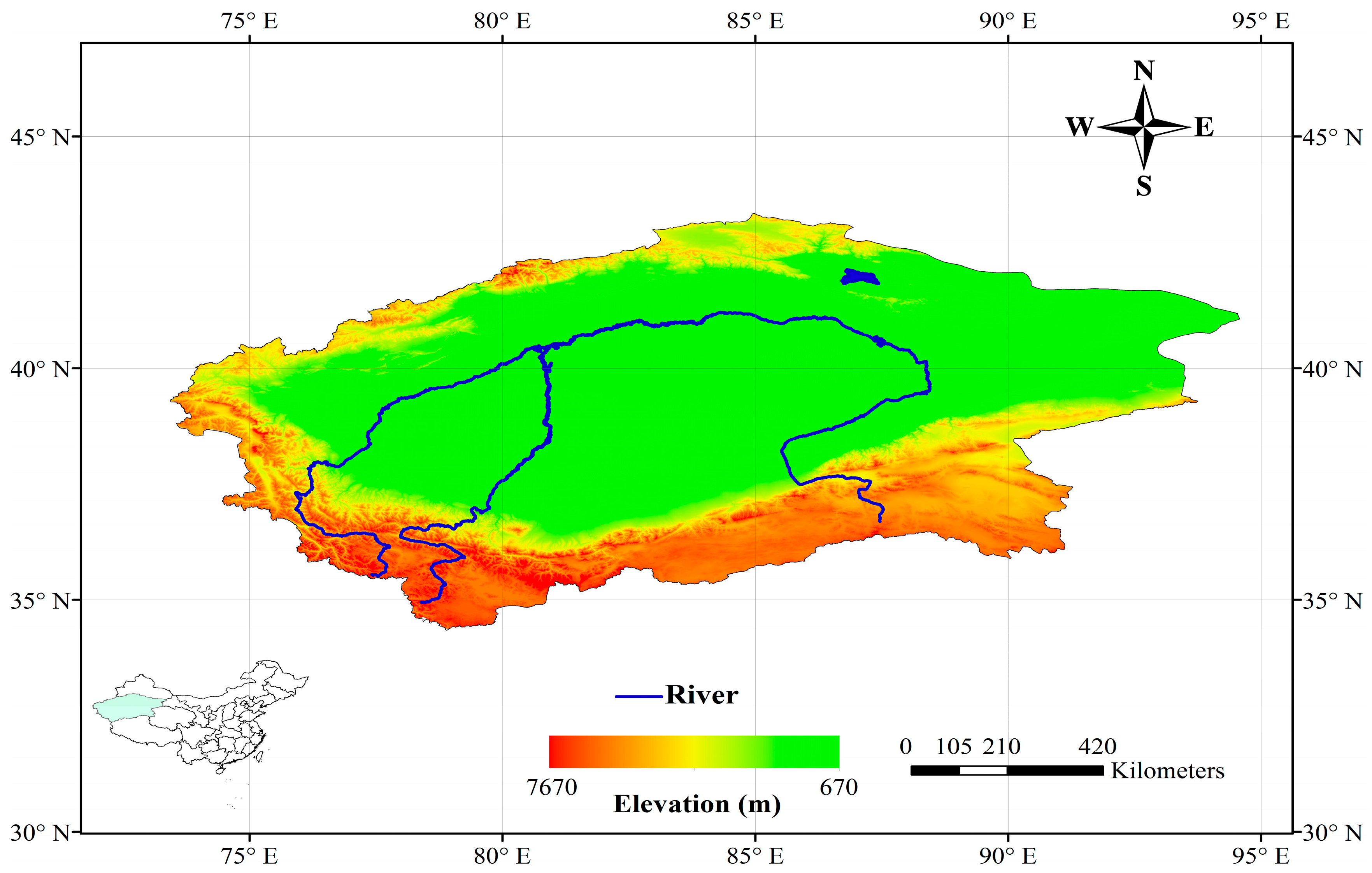
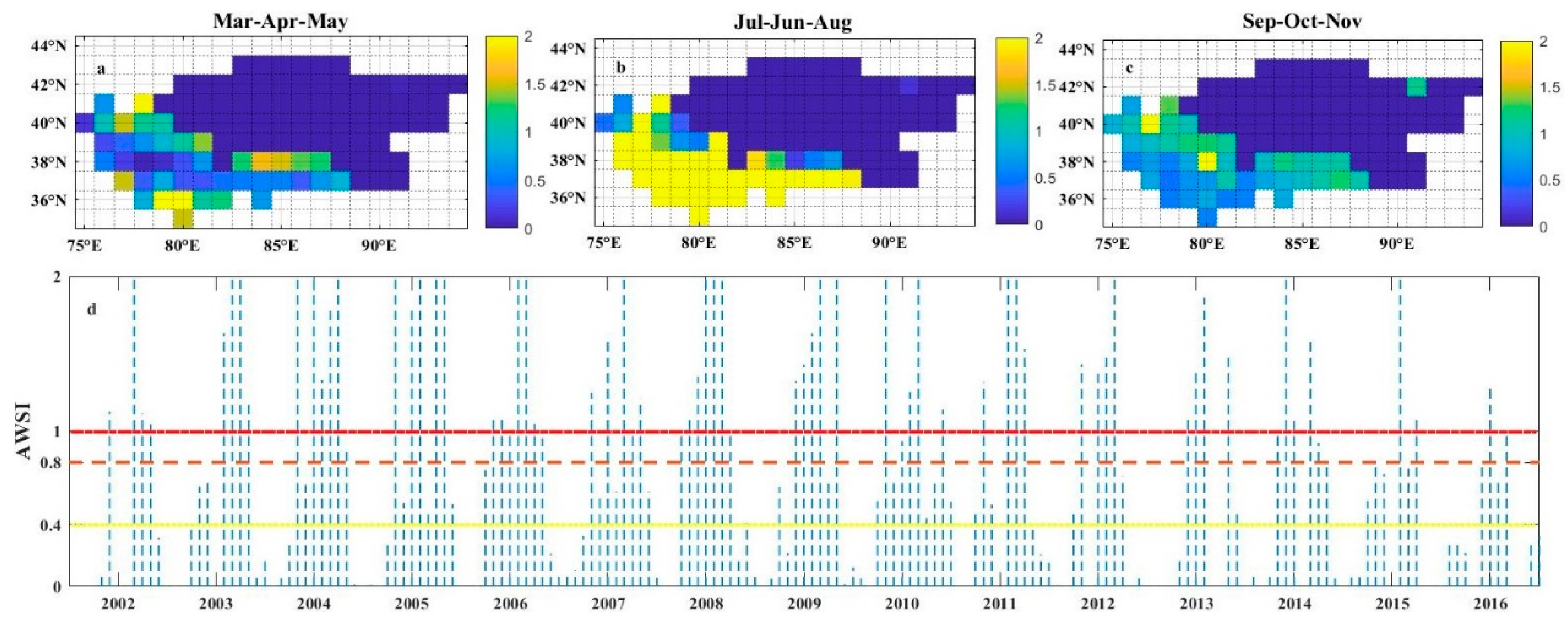
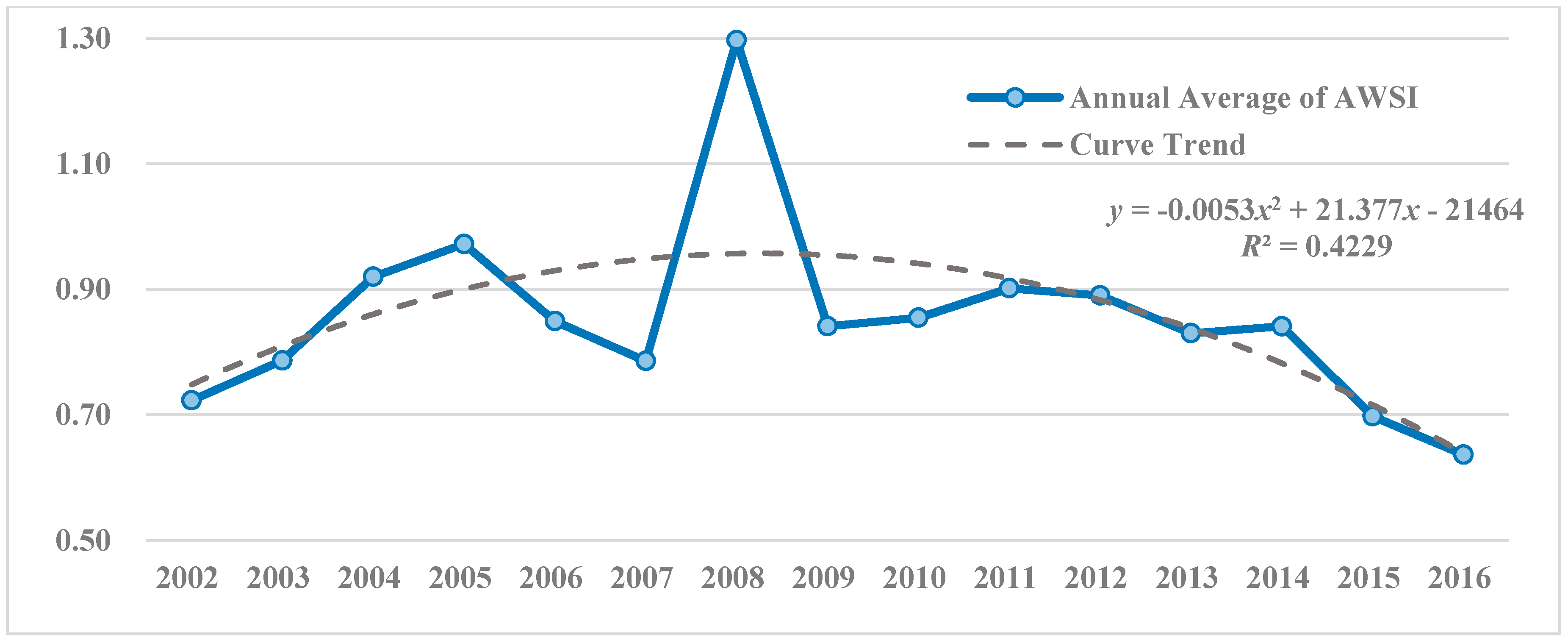
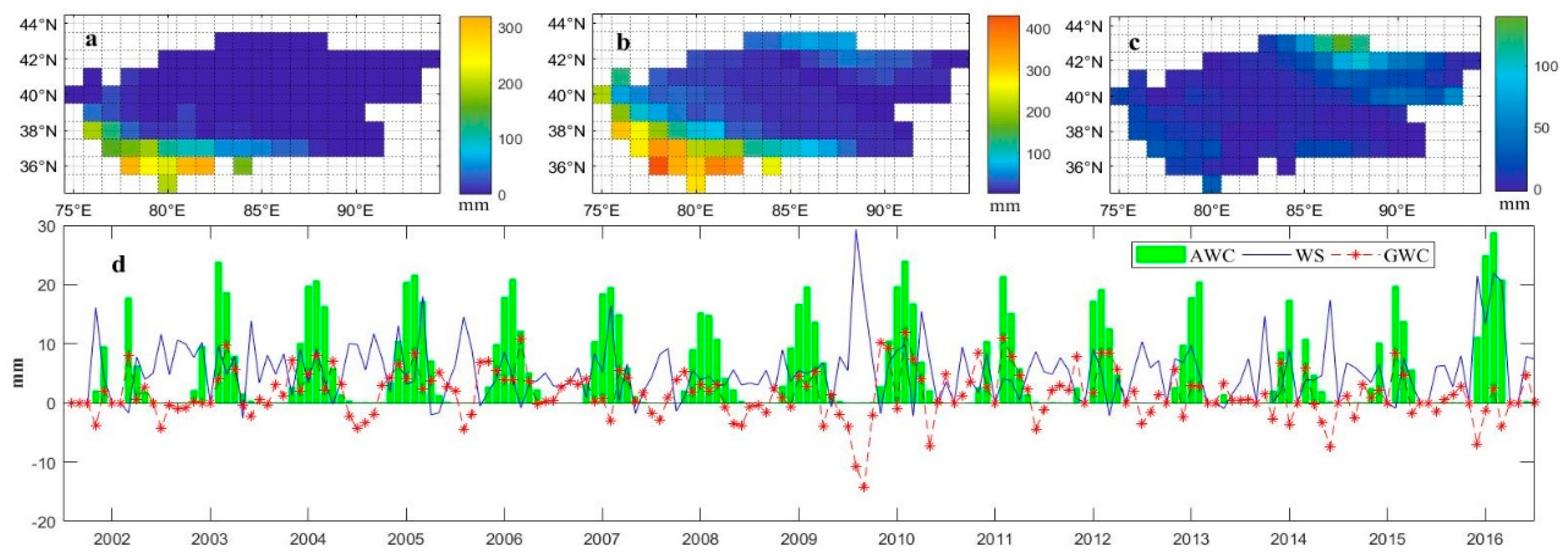
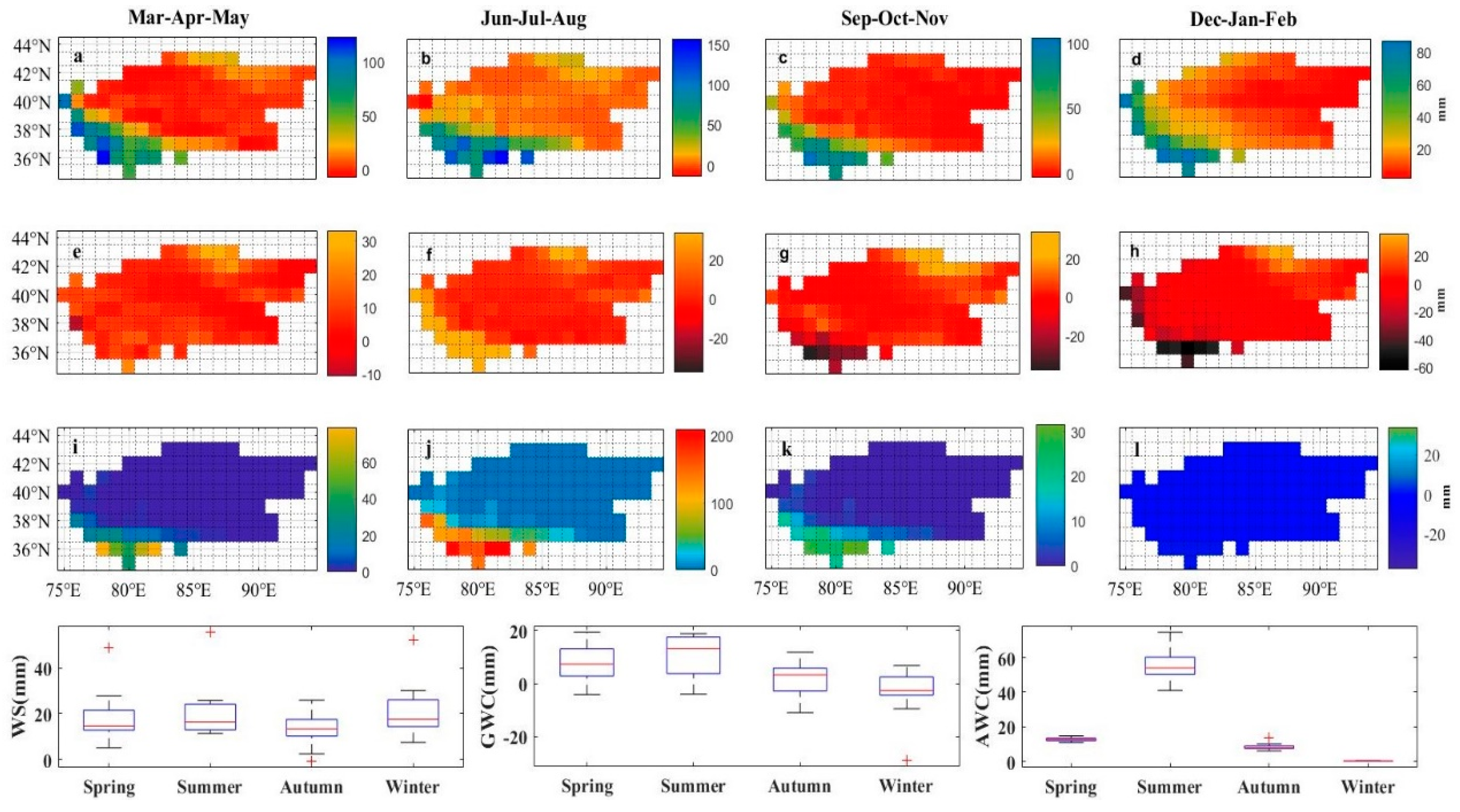
| Time | Months | |||||||||||
|---|---|---|---|---|---|---|---|---|---|---|---|---|
| Year | 1 | 2 | 3 | 4 | 5 | 6 | 7 | 8 | 9 | 10 | 11 | 12 |
| 2002 | Na | Na | Na | Na | Na | |||||||
| 2003 | Na | |||||||||||
| 2004 | ||||||||||||
| 2005 | ||||||||||||
| 2006 | ||||||||||||
| 2007 | ||||||||||||
| 2008 | ||||||||||||
| 2009 | ||||||||||||
| 2010 | ||||||||||||
| 2011 | Na | Na | ||||||||||
| 2012 | Na | Na | ||||||||||
| 2013 | Na | Na | Na | |||||||||
| 2014 | Na | Na | Na | |||||||||
| 2015 | Na | Na | Na | |||||||||
| 2016 | Na | Na | Na | |||||||||
© 2018 by the authors. Licensee MDPI, Basel, Switzerland. This article is an open access article distributed under the terms and conditions of the Creative Commons Attribution (CC BY) license (http://creativecommons.org/licenses/by/4.0/).
Share and Cite
Zhang, J.; Bai, M.; Zhou, S.; Zhao, M. Agricultural Water Use Sustainability Assessment in the Tarim River Basin under Climatic Risks. Water 2018, 10, 170. https://doi.org/10.3390/w10020170
Zhang J, Bai M, Zhou S, Zhao M. Agricultural Water Use Sustainability Assessment in the Tarim River Basin under Climatic Risks. Water. 2018; 10(2):170. https://doi.org/10.3390/w10020170
Chicago/Turabian StyleZhang, Jun, Minghao Bai, Shenbei Zhou, and Min Zhao. 2018. "Agricultural Water Use Sustainability Assessment in the Tarim River Basin under Climatic Risks" Water 10, no. 2: 170. https://doi.org/10.3390/w10020170
APA StyleZhang, J., Bai, M., Zhou, S., & Zhao, M. (2018). Agricultural Water Use Sustainability Assessment in the Tarim River Basin under Climatic Risks. Water, 10(2), 170. https://doi.org/10.3390/w10020170




